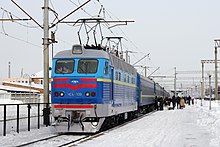Foreign trade of Communist Czechoslovakia
| Part of a series on the |
| Czechoslovak Socialist Republic |
|---|
 |
|
Economy Industry Agriculture Foreign trade Transport Education Demographics Government structure Health and social welfare Mass media Resource base Religion Society |
History and timeline
1948–1953
After the 1948 coup d'état, foreign trade enterprises successfully carried out the government's policy of rapidly redirecting the bulk of the country's foreign trade to communist states in the period from 1948 to 1953.
Many
1953–1960
After Joseph Stalin's death in 1953, Czechoslovak trade with the Western world gradually revived, although it still was far below prewar levels. More than two-thirds of the foreign trade continued to be with Comecon member states. Because of its relatively advanced industrial position within Comecon, Czechoslovakia initially had a secure market for its machinery and equipment exports. As years passed, however, the Soviet Union absorbed growing portions of Czechoslovakia's export capacity and very soon the country came to depend on the Soviet Union for imports of raw materials as well.
1960–1980
By the 1960s, it became clear that the country's dependence on foreign trade was substantial and that a restructuring of the economy was necessary.


In the 1970s, the government authorized a number of large enterprises to deal directly, or through affiliations with Czechoslovak foreign trade companies, with foreign purchasers of their products. To encourage further export and modernization, the central authorities permitted Czechoslovak firms to retain a regulated portion of export proceeds. Authorities also acknowledged that the economy seriously lagged behind the non-communist
In the mid-1970s, the
During the late 1970s, the terms of trade continued to worsen; greater and greater quantities of exports were required to purchase the same volume of imports. The combination of worsening terms of trade and the difficulty of expanding exports caused Czechoslovakia's trade imbalance to grow in almost every area. Between 1975 and 1979, the country's excess of imports over exports was nearly US$1.2 billion with the Soviet Union, US$690 million with Eastern Europe, and US$3.3 billion with noncommunist developed countries. These imbalances emerged despite efforts to conserve fuel and raw material use, to slow the volume of other imports, and to increase exports.
During the 1970s, Czechoslovakia, like other countries of Eastern Europe, turned to West European
Czechoslovakia did not publish information on these credits. However, one Western estimate placed Czechoslovakia's hard currency debt to the West at the end of 1979 at US$4 billion
1980–1991
Beginning in 1980, Czechoslovakia was able to achieve a
However, at the end of 1984, Czechoslovakia could boast one of the lowest net hard currency debts per capita (about US$15 per inhabitant) in Eastern Europe; only Bulgaria's debt was lower. With the Soviet Union, by contrast, Czechoslovakia continued to run a substantial deficit.
In the mid-1980s, according to official statistics, Czechoslovak trade activities remained overwhelmingly oriented toward intra-Comecon trade. Within Comecon, in keeping with the plan for regional specialization set forth in the Comprehensive Program of 1971, Czechoslovakia concentrated on production of
Most Western analysts believed that official Czechoslovak methods of calculation tended to overstate considerably the value of trade conducted in transferable rubles, i.e., with Comecon partners, and to underestimate the value of hard currency trade with non-communist countries. Nevertheless, the general structure of Czechoslovakia's foreign trade was unmistakable.
Organization
Under the Czechoslovak system, foreign trade was a state
The
Foreign exchange and exchange rate
An important characteristic of the Soviet model that was imposed on Czechoslovakia in 1948 was the attempt to insulate the domestic economy and minimize the impact of world economic trends. The system accomplished this in part by severely restricting foreign currency transactions and confining them to official channels at fixed and favorable exchange rates. Within a few years, the exchange rate had lost its historical basis and no longer bore any direct relationship to purchasing power in other currencies.
Trade partners
Major partners
Czechoslovak trade was heavily concentrated among a relatively small group of countries. According to official statistics, five countries accounted for 71.7% of all
The Soviet Union exerted a powerful influence over the Czechoslovak economy. In 1985 it accounted for 44.8% of foreign trade turnover, according to official statistics.
In 1985 by far the most important export from Czechoslovakia to the Soviet Union was machinery and various kinds of equipment, such as machine tools, power generating equipment, instruments and laboratory equipment, agricultural machinery, railroad rolling stock and other transport equipment, and equipment for the food, textile, and chemical industries. Such items made up over 60% of exports to the Soviet Union.
Other minor items were
Among noncommunist countries, an important trade partner was West Germany (fifth in rank). Principal Czechoslovak exports to West Germany in 1985 were various manufactured goods (especially paper and paperboard, textiles, and iron and steel products), mineral fuel products (briquettes, coke, and refined petroleum products), and chemical products. Principal imports from West Germany were machinery (textile- and leather-working machinery, machine tools, and electrical machinery and instruments), chemical products, and various manufactured goods.
Other partners
Other East European Comecon countries, such as
Other significant trading partners were
.Czechoslovak trade with the
During the late 1970s and early 1980s, Czechoslovakia had imported substantial amounts of grain from the United States, but more abundant domestic harvests enabled the country to reduce these imports in the mid-1980s.
References
![]() This article incorporates text from this source, which is in the public domain. Country Studies. Federal Research Division.
This article incorporates text from this source, which is in the public domain. Country Studies. Federal Research Division.
- Journal of European Integration History, 2004, Volume 10, Number 2
